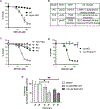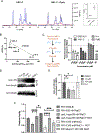Discovery of a Pseudomonas aeruginosa-specific small molecule targeting outer membrane protein OprH-LPS interaction by a multiplexed screen
- PMID: 39732052
- PMCID: PMC12117999
- DOI: 10.1016/j.chembiol.2024.12.001
Discovery of a Pseudomonas aeruginosa-specific small molecule targeting outer membrane protein OprH-LPS interaction by a multiplexed screen
Abstract
The surge of antimicrobial resistance threatens efficacy of current antibiotics, particularly against Pseudomonas aeruginosa, a highly resistant gram-negative pathogen. The asymmetric outer membrane (OM) of P. aeruginosa combined with its array of efflux pumps provide a barrier to xenobiotic accumulation, thus making antibiotic discovery challenging. We adapted PROSPECT, a target-based, whole-cell screening strategy, to discover small molecule probes that kill P. aeruginosa mutants depleted for essential proteins localized at the OM. We identified BRD1401, a small molecule that has specific activity against a P. aeruginosa mutant depleted for the essential lipoprotein, OprL. Genetic and chemical biological studies identified that BRD1401 acts by targeting the OM β-barrel protein OprH to disrupt its interaction with LPS and increase membrane fluidity. Studies with BRD1401 also revealed an interaction between OprL and OprH, directly linking the OM with peptidoglycan. Thus, a whole-cell, multiplexed screen can identify species-specific chemical probes to reveal pathogen biology.
Keywords: LPS; OprH; Pseudomonas aeruginosa; Tol-Pal; chemical screening; gram-negative bacteria; growth inhibitor; lipopolysaccharide; outer membrane.
Copyright © 2024 Elsevier Ltd. All rights reserved.
Conflict of interest statement
Declaration of interests The authors declare no competing interests.
Figures







Update of
-
"Multiplexed screen identifies a Pseudomonas aeruginosa -specific small molecule targeting the outer membrane protein OprH and its interaction with LPS".bioRxiv [Preprint]. 2024 Mar 16:2024.03.16.585348. doi: 10.1101/2024.03.16.585348. bioRxiv. 2024. Update in: Cell Chem Biol. 2025 Feb 20;32(2):307-324.e15. doi: 10.1016/j.chembiol.2024.12.001. PMID: 38559044 Free PMC article. Updated. Preprint.
References
-
- Tacconelli E, Carrara E, Savoldi A, Harbarth S, Mendelson M, Monnet DL, Pulcini C, Kahlmeter G, Kluytmans J, Carmeli Y, et al. (2018). Discovery, research, and development of new antibiotics: the WHO priority list of antibiotic-resistant bacteria and tuberculosis. Lancet Infect Dis 18, 318–327. 10.1016/S1473-3099(17)30753-3. - DOI - PubMed
MeSH terms
Substances
Grants and funding
LinkOut - more resources
Full Text Sources
Medical

